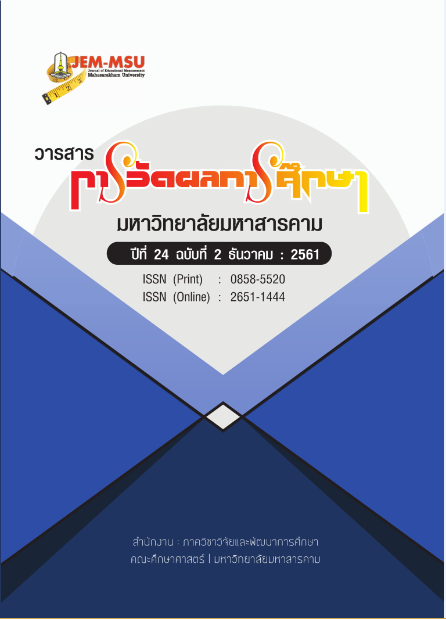The Real Meaning of IOC
Main Article Content
Abstract
The objective of this article is to present Rovinelli and Hambleton’s concept on inventing “The Index of Item-Objective Congruence” (IOC) by presenting formulas that appeared in academic articles which could be retrieved in Thailand. And also, this article presents the analysis of similarities and differences among the IOC formulas that have appeared in various academic sources as well as the conditions of using the formulas as given by the academicians who invented them. One important point that has been retrieved is that, according to the original concept of IOC, the index is aimed to be used for item validation in a criterion-referenced test which has more than 1 objective, and each single item in that test aims to measure only any one of the objectives. However, the study found that the application of IOC in Thailand happens to suggest in such a way that it is meant for item validation of any single objective of the test, and therefore the arithmetic mean () is used instead of the IOC.
Article Details
The content and information contained in the published article in the Journal of Educational Measurement Mahasarakham University represent the opinions and responsibilities of the authors directly. The editorial board of the journal is not necessarily in agreement with or responsible for any of the content.
The articles, data, content, images, etc. that have been published in the Journal of Educational Measurement Mahasarakham University are copyrighted by the journal. If any individual or organization wishes to reproduce or perform any actions involving the entirety or any part of the content, they must obtain written permission from the Journal of Educational Measurement Mahasarakham University.
References
กรุงเทพฯ : จุฬาลงกรณ์มหาวิทยาลัย.
Hambleton, R.K. (1984). Validating the test scores. In R. A. Berk. (Ed). A guide to criterion
-referenced test construction. (199 – 223). Baltimore and London : The Johns
Hopkins University Press.
Nitko, A.J. and Hsu, T. (1984). Item Analysis appropriate for domain-referenced classroom
Testing. (Project Technical Report Number 1). Paper presented at the annual
meeting of the American Educational Research Association : Los Angeles. April
23 – 27, 1984). [Online] Available : https://files.eric.ed.gov/fulltext/ED242781.pdf.”
Retrieved Feb 3, 2018.
Rovinelli, R.J. (1976). Methods for Validating Criterion-Referenced Test Items. Unplblisded
Doctoral Dissertation. University of Massachusetts Amherst. ). [Online] Available :
https://scholarworks.umass.edu/cgi/viewcontent.cgi?referer=https://www.google.
Co.th/&httpsredir=1&article=4661&context=dissertations_1 “
Rovinelli, R.J. and Hambleton, R.K. (1976). On the use of content specialists in the
assessment of criterion-referenced test item validity. Paper presented at the annual
meeting of the American Educational Research Association : California. April 19 –
23, 1976)0 [Online] Available : https://files.eric.ed.gov/fultlext/ED121845.pdf.
Retrieved Feb 3, 2018.
Turner, R.C., Mulvenon, S.W., Thomas, S.P. and Balkin, R.S. (2002). Computing Indices of
Item Congruence for Test Develpoment Validity Assessments. [Online]
Available : “https://www2.sas.comproceedings/sugi27/p255-27.pdf.“
Retrieved Feb 3, 2018.


